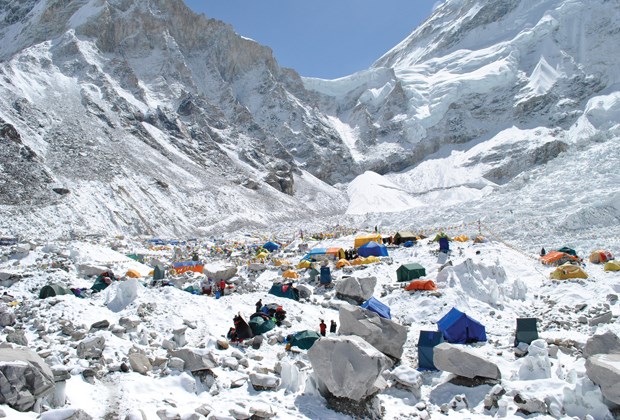Book Launch: Base Camp: 40 Days on Everest by Dianne Whelan. A slideshow and talk, Thursday, April 17, 7-9 p.m. at Capilano University's Bosa Centre Theatre. Free.
"Everest always has the last word," says Dianne Whelan. "It's the biggest mountain in the world and she's called a goddess and I'll tell you she's a mean mother, OK. She's not a kind mother, she's a mean mother. And you can have the biggest ego in the world, but I don't care who you are, you're not walking away without a dose of humility when you leave that place."
Whelan, a filmmaker, photographer, multimedia artist and author, travelled to Nepal in 2010 and spent 40 days at Mount Everest's base camp. Proving to be both an illuminating and humbling experience, she first shared her story in an award-winning film, 40 Days at Base Camp. This week, she's releasing a book about the trip, Base Camp: 40 Days on Everest, through Caitlin Press. Whelan's experience as well as that of the many climbers, doctors and Sherpas she came to know, are woven together in the work, along with a discussion of the effects of climate change on the Everest area. Next year, she plans to release a related app.
Whelan will offer insight into the book at a launch event, Thursday, April 17 at 7 p.m. at Capilano University's Bosa Centre Theatre. She's pleased to be presenting her slideshow and talk at her alma mater, which set her on her current three-pronged approach to storytelling.
A storyteller from a young age, Whelan, who lives on the Sunshine Coast on Garden Bay in Pender Harbour, pursued a career in journalism, mainly photography. A successful contributor to a number of media outlets, like the Vancouver Sun and Whistler Question, she eventually had an epiphany.
"I realized through the photojournalism that it was really the storytelling, the narrative of the photograph, that was intriguing me more than the writing. The beautiful thing about filmmaking is you get to actually incorporate all of it anyway - you get the narrative of the moving image, you get sound and you get story," she says.
At age 40, Whelan, now 48, decided to go to film school at Capilano University.
"The documentary just gives you a lot more space to breathe.. .. It just sat better with me as the kind of storytelling that I wanted to do," she says.
Whelan now takes a multi-platform approach to each of her projects, allowing her to combine all of her passions. A previous initiative saw her release This Land, a documentary made with the support of the National Film Board, highlighting her travels in the Canadian High Arctic on a historical Sovereignty Patrol. It was followed by the book This Vanishing Land as well as an interactive website.
"Every medium offers you a different opportunity to tell a different version of the story," she says.
Her Everest base camp project came together as a result of an assignment from Outpost Magazine. When she returned from her Arctic journey in 2007, the publication asked her if she wanted to go to Everest to write a story.
Whelan jumped at the once-in-a-lifetime opportunity.
"I was so excited to go there," she says.
She had long been inspired by the mountaineering duo that first reached the mountain's summit in 1953, New Zealand's Sir Edmund Hillary and Nepalese Sherpa Tenzing Norgay. Personal heroes growing up, to
this day, she views their accomplishment as a "beautiful metaphor for human ambition."
"I had grown up with a picture of Hillary and Tenzing in my bedroom that I'd cut out of (National Geographic magazine) and put in my copy of The Hobbit. And off now I was to this mythical mountain. And when I got there finally, after the hike in and everything, I was just ravaged by what I saw," she says.
Despite her knowledge of base camp, its realities were shocking. The amount of garbage present and the tales of oxygen being stolen were the tip of the iceberg. The estimated 250 dead bodies buried on the path from base camp to the peak, the lineups, the high cost of an ascent and other challenging conditions made a lasting impact.
Whelan vowed to one day go back to tell the true story of the mountain, and did so in 2010.
Inspired by a proverb she read before she left, "To know a people you must spend 40 days with them," she committed to stay for more than a month.
"I wondered if I spent that amount of time there if my first impression would shift and it did. The first time I went there I was really abhorred by everything I saw. And it's still there, the garbage and the dead bodies and there's still a part of it that doesn't sit well with me. But I also met incredibly inspiring people who seek out to do this and to go there from all over the world," she says.
Whelan walked away from the experience forever changed.
"We all set a limit, we all set a ceiling on what we can accomplish and for some reason climbing that mountain really breaks that ceiling open for a lot of people," she says.
For her next project, The Story of White Raven, Whelan is exploring First Nations legends and related environmental issues. She's currently filming and conducting research from coast to coast.
In addition to next Thursday's talk at Capilano University, Whelan has a number of other local speaking engagements planned. Visit basecamp40daysoneverest. com for details.



